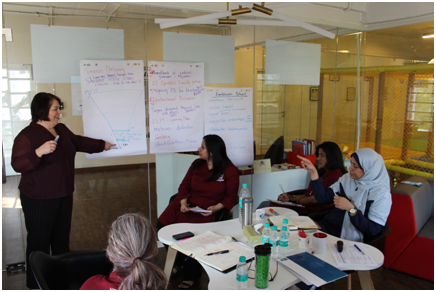A Week with Kristen Pelletier, Next Frontiers Inclusion Consultant
New York Academy Teacher Professional Growth
 What We Learned
What We Learned
I wrote last week about the upcoming visit of Kristen Pelletier, one of the most recognized specialists and experts on the international schools circuit for differentiation. Kristen was here to provide NYA with professional development for all things inclusion, differentiated instruction, and personalized learning.
It was an amazing week! Our faculty was fully engaged.
We gained understandings and ready to implement strategies to take back to the classroom to benefit NYA students.

Three Essential Questions
We were guided to engage in meaningful conversation and practice to consider three essential questions:
- 1)What does differentiation look like in the classroom?
- 2) What are the values and beliefs shared by a faculty to meet the personalized learning needs of all students?
- 3)What strategies and plans do teachers use for differentiated instruction and personalized learning?
Four Keys to Differentiation
We gained a deep understanding of ways to build our science and art of teaching through four keys to differentiation:
- 1)Know your students (academic, social, and emotional profiles).
- 2)Know your curriculum.
- 3)Develop a repertoire of instructional and learning strategies.
(All instruction must be followed with immediate opportunities for processing, applying, and practicing for learning and retention to occur.) - 4)Keep it simple and social.
The following will make this blog longer than most I write, but I would like to share with you one best practice instructional strategy we were provided by Kristen. Having read this strategy in collaborative groups of 4, our teachers engaged in meaningful conversations to build and shape their understanding and think about how they might implement it in their classrooms.
Differentiation Strategies: Learning Contracts
Learning Contracts combine several aspects of differentiation that have been shown to be effective in promoting student learning. Learning Contracts are in essence a negotiated agreement between the student and the teacher regarding the tasks and activities that the student will complete in order that he or she develop the required understandings and acquire the necessary skills. The design of most Learning Contracts is teacher directed, but the student often works on the activities or tasks with considerable independence. Many teachers include in Learning Contracts a fair degree of student choice regarding what is to be learned (the content), working conditions (individual or group work) and how the learning will be demonstrated (production styles).
Like other learning experiences in the classroom, the assessment of Learning Contracts can take a number of different forms. One 4th grade teacher we know assesses her students’ Learning Contracts in three ways.
- First she looks at how well each student worked (goal clarity, on-task behavior, perseverance oncetowards thegoal, useof feedback, revision).
- Secondlyshechecksoneortwo of the assignments to determine their completion, accuracyandoverallquality.
- Thirdly, each student chooses two assignments (one must be a written assignment) for inclusion in his or her portfolio. Each assignment is self-assessed, assessed by a peer,and finally assessed by the teacher against a rubric that was distributed to the closes to the start of the unit.
Characteristics of a Learning Contract- A High Quality Learning Contract
- Holds the teacher responsible for specifying important learning goals and outcomes and for making sure that students acquire them;
- Presumes that students can take some responsibility for learning:
- Identifies the skills and processes that students need to practice and acquire;
- Ensures that students will use those skills in a meaningful context;
- Makes explicit the conditions under which the Contract will be executed
(student behavior, deadlines, classwork involvement in the Learning Contract and homework); - Establishes positive consequences for adhering to agree upon working conditionsandcontract for completion (continued independence, student choice, grades). Teachers con also set negative consequences if students do not adhereto agreed working conditions;
- Makes explicit at the start of the contract the criteria for successful completion and quality of work;
- Includes the signatures of agreement of both student and teacher.
Learning Contracts in Action: “The Night of the Notables” – A Sample Unit of Study
The Grade Five Team of teachers look forward to their unit entitled “The Night of the Notables.” Over the last three years it has evolved into a powerful learning experience for their students, and one that the students and their parents greatly enjoy. The teachers have identified three essential questions for the unit:
- What are some common characteristics of heroes?
- How does the passage of time change our perceptions of popular heroes?
- What qualities make some heroes greater than others?
In terms of skills and processes the teachers want their students to develop their research skills both in terms of print and electronic media, to hone their expository essay writing skills and to develop a sense of historical empathy.
The unit starts with the students watching a short film on the life of Harriet Tubman. Small groups discuss and identify the qualities that made Tubman a hero. The groups then read a short article on the Burmese dissident Aung Son Suu Kyi. The teachers encourage the students to compare the two women. The groups prepare posters showing both similarities and differences.
The teachers then distribute to the students a long list of possible heroes for them to choose from. The students are asked to take the list home and consult with their parents about the selection of a hero to research. The choices range from heroes in sports, politics, science, medicine, exploration, art, music, literature, human rights, etc. Once the students have made their selection; the teacher gives them their assignment card and the learning contract. The contract states that they must research their “Notable” and answer a series of questions about him or her and the contribution that he or she made. The students must make a brief power point presentation on their “Notable” and write a five paragraph essay explaining why this Person was truly notable (and how his or her personal characteristics matched those of a hero).
The students must then prepare for the “Night of the Notables”. This is an evening event to which the students come dressed as their “Notable”. The students gather in the gymnasium and the parents are held outside. At a specific signal, the doors of the gym are opened and the parents are permitted to enter. The students stand frozen in costume with props representing their “Notable.”Parents move among the “statues” asking questions and trying to guess whom each student is.
This is meaningful engaged differentiated learning at it’s best! And this is the type of Best Practice being implemented at New York Academy.

